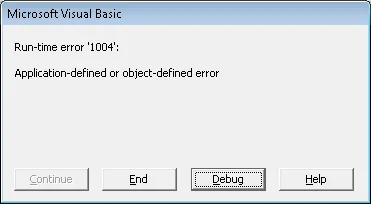以下是使用C#动态创建依赖下拉列表的通用尝试。当从pick1选择值“A”时,pick2应该显示来自SecondaryRangeA的值。
这段代码几乎可以正常工作,但它显示的不是SecondaryRangeA,而是字面值“A”。
当我将代码修改为以下内容时,会出现异常。有任何想法吗?
这段代码几乎可以正常工作,但它显示的不是SecondaryRangeA,而是字面值“A”。
pick2.Validation.Add(XlDVType.xlValidateList,
XlDVAlertStyle.xlValidAlertStop,
XlFormatConditionOperator.xlBetween,
"=INDIRECT(\"A5\")");
当我打开导出的Excel并修改数据验证时,它会显示公式。
=INDIRECT("A5")
如果我在Excel中手动修改公式以排除引号,它的表现符合预期。
=INDIRECT(A5)
当我将代码修改为以下内容时,会出现异常。有任何想法吗?
pick2.Validation.Add(XlDVType.xlValidateList,
XlDVAlertStyle.xlValidAlertStop,
XlFormatConditionOperator.xlBetween,
"=INDIRECT(A5)");
异常:
System.Runtime.InteropServices.COMException was unhandled
ErrorCode=-2146827284
Message=Exception from HRESULT: 0x800A03EC
Source=""
StackTrace:
at System.RuntimeType.ForwardCallToInvokeMember(String memberName, BindingFlags flags, Object target, Int32[] aWrapperTypes, MessageData& msgData)
at Microsoft.Office.Interop.Excel.Validation.Add(XlDVType Type, Object AlertStyle, Object Operator, Object Formula1, Object Formula2)
at TestExcelValidation.Program.Main(String[] args) in C:\TFS\ExcelInterop\TestExcelValidation\Program.cs:line 44
at System.AppDomain._nExecuteAssembly(Assembly assembly, String[] args)
at Microsoft.VisualStudio.HostingProcess.HostProc.RunUsersAssembly()
at System.Threading.ExecutionContext.Run(ExecutionContext executionContext, ContextCallback callback, Object state)
at System.Threading.ThreadHelper.ThreadStart()
InnerException:
完整示例:
using System.Collections.Generic;
using System.IO;
using System.Linq;
using Microsoft.Office.Interop.Excel;
namespace TestExcelValidation
{
class Program
{
static void Main(string[] args)
{
string temporaryPath = Path.GetTempPath();
string temporaryFile = Path.GetTempFileName();
Application appl = new Application();
appl.Visible = true;
Workbook workbook = appl.Workbooks.Open(temporaryFile, 0, true, 5, "", "", true, XlPlatform.xlWindows, "\t", false, false, 0, true, 1, 0);
Worksheet worksheet = (Worksheet)workbook.Worksheets.Add();
List<string> primaryList = new List<string>();
primaryList.Add("A");
primaryList.Add("B");
List<string> secondaryListA = new List<string>();
secondaryListA.Add("A1");
secondaryListA.Add("A2");
secondaryListA.Add("A3");
List<string> secondaryListB = new List<string>();
secondaryListB.Add("B1");
secondaryListB.Add("B2");
secondaryListB.Add("B3");
Range primaryRange = AddToExcelNamedRange(worksheet, primaryList, 'A', 1, "PrimaryRange");
Range secondaryRangeA = AddToExcelNamedRange(worksheet, secondaryListA, 'B', 1, "A");
Range secondaryRangeB = AddToExcelNamedRange(worksheet, secondaryListB, 'C', 1, "B");
Range pick1 = worksheet.Range["A5"];
pick1.Validation.Add(XlDVType.xlValidateList, XlDVAlertStyle.xlValidAlertStop, XlFormatConditionOperator.xlBetween, "=PrimaryRange");
Range pick2 = worksheet.Range["A6"];
pick2.Validation.Delete();
pick2.NumberFormat = "Text";
pick2.Validation.Add(XlDVType.xlValidateList, XlDVAlertStyle.xlValidAlertStop, XlFormatConditionOperator.xlBetween, "=INDIRECT(\"A5\")");
pick2.Validation.InCellDropdown = true;
pick2.Validation.IgnoreBlank = true;
}
private static Range AddToExcelNamedRange(Worksheet worksheet, List<string> primaryList, char col, int row, string rangeName)
{
Range range = worksheet.Range[col.ToString() + row.ToString(), col.ToString() + primaryList.Count().ToString()];
range.Name = rangeName;
foreach (string item in primaryList)
{
worksheet.Cells[row, col - 64] = item;
row++;
}
return range;
}
}
}

